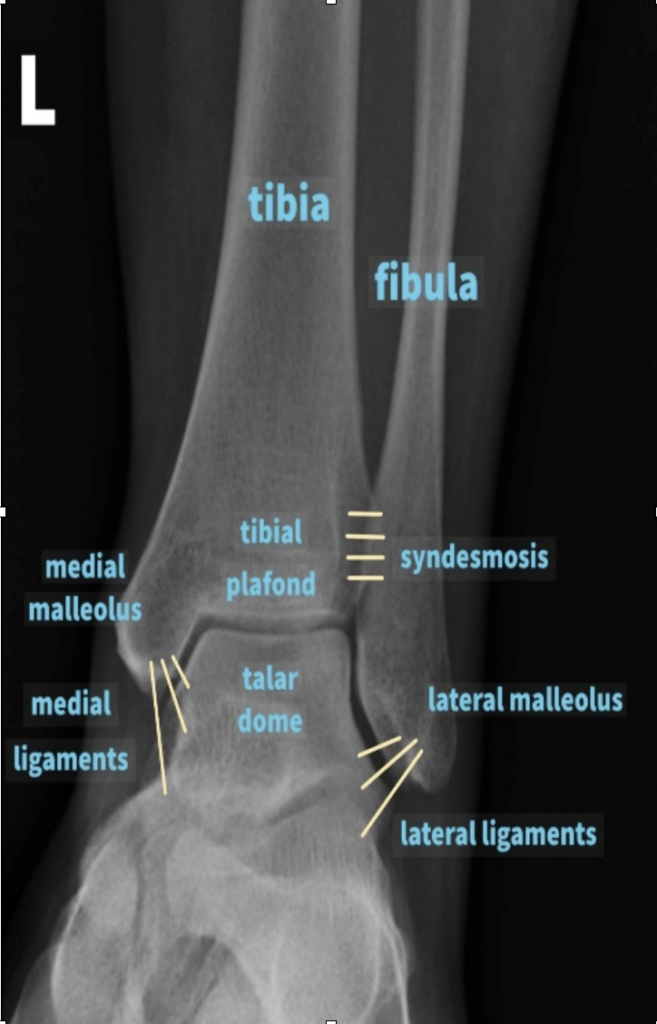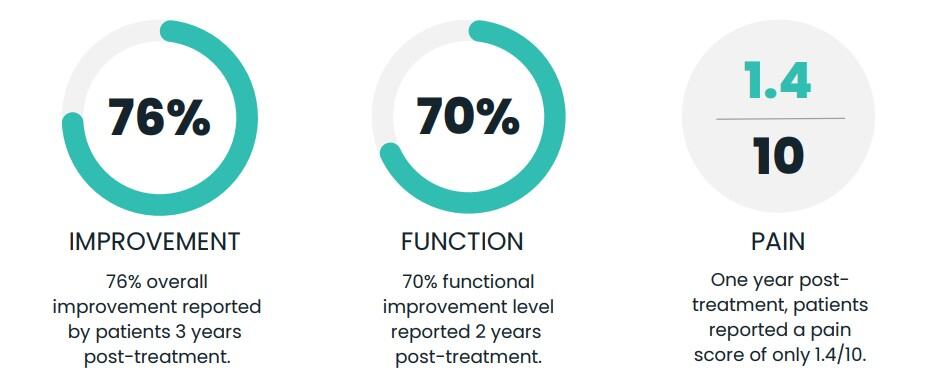Is chronic ankle pain holding you back from being as active as you want to be? Today, let’s take a deep dive into the ankle joint and discuss one of our patients’ journeys with ankle arthritis and how he has avoided ankle fusion or replacement with Regenexx-C!
The Ankle Joint
The ankle joint, also known as the tibiotalar joint, is a complex hinge joint that plays a crucial role in the movement and stability of the foot. It allows for the up-and-down motion of the foot, which is essential for walking, running, and jumping. The ankle joint is formed by the articulation of three bones: the tibia, the fibula, and the talus.
Anatomy of the Ankle Joint
Tibia: The larger of the two bones in the lower leg (the shinbone), the tibia contributes to the ankle joint by its lower end, known as the medial malleolus, which forms the inner aspect of the ankle.
Fibula: The thinner bone alongside the tibia, the fibula’s lower end is called the lateral malleolus and forms the outer aspect of the ankle.
Talus: A bone in the foot that sits between the heel bone (calcaneus) and the tibia and fibula, the talus transfers the weight and pressure from the leg to the foot.

Joint Structure
The surfaces of the tibia, fibula, and talus that come into contact are covered with articular cartilage, a smooth, slippery substance that enables the bones to move smoothly against each other. The joint is enclosed in a fibrous joint capsule, which is lined with a synovial membrane that produces synovial fluid for lubrication.
Ligaments Supporting the Ankle
The stability of the ankle joint is provided by several ligaments, which are bands of tough, elastic tissue that connect bones to each other:
Medial collateral ligaments (deltoid ligament): Ligaments that support the inner side of the joint and resist excessive eversion (outward turning) of the foot.
Lateral collateral ligaments: A group of ligaments that support the outer side of the ankle and resist excessive inversion (inward turning) of the foot. This group includes the anterior talofibular ligament, the posterior talofibular ligament, and the calcaneofibular ligament.
Syndesmotic ligament: This connects the tibia and fibula together, providing stability to the ankle joint.
Function
The primary movements of the ankle joint are dorsiflexion (raising the foot upwards) and plantarflexion (pointing the foot downwards). These movements are essential for various activities, allowing for adjustments in terrain and the performance of complex tasks. The ankle also plays a role in inversion and eversion movements, though these are primarily attributed to the subtalar joint and other foot structures.
The ankle joint’s unique structure and the interplay of bones, ligaments, and muscles allow it to bear the body’s weight while providing flexibility and stability. It’s crucial for locomotion and balance, adapting to different surfaces, and enabling a wide range of activities, from walking to high-impact sports. Due to its load-bearing function and complexity, the ankle is susceptible to injuries and conditions like sprains, fractures, and arthritis, which can significantly affect mobility and quality of life.
Ankle Arthritis
We can see how vital the ankle joint is for almost every function. So, when an ankle becomes arthritic, it can cause severe disability and limitations!
Meet DC,
I first met and treated DC back in 2019. DC came to us with a long history as an endurance athlete that had been limited due to his ankle arthritis. Here is his response several years out from treatment:.
“I could go on for a long time here and would be happy to jump on a call if you wanted more details, but I am doing AWESOME. In April 2021, I was not in a great place because that half-ironman I do every year is in July, and I needed to start putting some running in if I was going to NOT DIE, basically, but I was still having pain and things just didn’t feel great. I was even questioning whether it was a good idea to do it actually. Long story short, I got out there and was able to train pretty well and log some miles and ended up just 2 minutes off my best time in the 15 years I’ve done it. New sneakers with 13-mm drop, some orthotics, and some work on my running form were the game changers, I think.
Then, we just did our holiday snowboard trip up to Stowe, and I was blown away. First time I have carved a turn on my toe edge, basically without any pain. Boarded all week with no issues. Even hit one of the big booters in the park like I used to and didn’t think about the landing and pain I would usually have to endure. Crazy.
It seems like I was still improving and hit my peak at 2 years post-injections, with most of the great strides being between 1.5 and 2 years. If someone asked me at 1.5 if I would do it all over again, it wasn’t an easy question to answer. Now if someone asks me, I tell them you are a genius and stem cells are the future!!
I was in a place where I was beginning to think I needed to start seriously considering my surgery options again, but that is completely out of my mind. I honestly believe I can potentially manage it with injections if I start to notice any backsliding.”
A few years after this, DC was able to get so active that he created a small stress fracture in his ankle. After some rest, that too resolved on its own, but we had decided to retreat the joints as a “tune up.”
Here is his latest response:
Hey Doc, how goes it?! Hope you and the fam are doing well. I’ve been meaning to write you for a while now to tell you how great I am doing, and I can’t put it off any longer as I just completed Ironman Florida this past Saturday. Not only did I complete it, but I did quite well, and to be honest with you, I didn’t even really feel the ankle. I am completely out of orthotics and feeling great. You are clearly a genius!
You may or may not remember, but I don’t really consider myself a “triathlete,” but it keeps me busy and moving and something to put on the calendar and train for. But after all this swimming, biking, and running, I’m looking forward to getting back in the gym and working on some strength. And it’s so cool that my ankle is in such a good place. I honestly think about it multiple times a day and am truly grateful.
Perhaps you get these kinds of emails all the time, but I’m sure you’ll never get tired of hearing it. So, THANK YOU, THANK YOU, THANK YOU for getting me back to where I wanted to be, and doing things I never thought I’d be able to do again. We got off to a rocky start there, but it all fell into place eventually!!
Maybe down the road I’ll feel like I need another preventative injection just to keep things going in the right direction, but I’d say my ankle is stronger now than when I started training for Ironman!
Ankle Arthritis Outcomes
We couldn’t have been happier with DC’s outcome and ability to give him back much of his life without the need for surgery. But looking at our outcome data through our registry, this outcome is to be expected and is why we have used cultured expanded MSC treatment for advanced arthritis for the last 20 years!
Ankle & Foot Patient Outcomes
Regenexx maintains an active registry that tracks the post-procedure outcomes of patients. Here are some of the major findings from this outcome data for ankle and foot patients*.

Conclusion
DC was right; we are fortunate to receive many emails of success from our patients! Even years later. If you have been dealing with ankle pain and would like to avoid surgery, contact our patient care team to set up an evaluation with one of our experts to see if you are a candidate for treatment!
Written by Dr. Jason Markle
*Outcome data correct as of February 2025.
To find out more about Regenexx-C, speak to our patient care team on 1-877-211-3834 (U.S. Toll-free), 1-345-943-5900 (Cayman), or by email at info@regenexxcayman.ky.